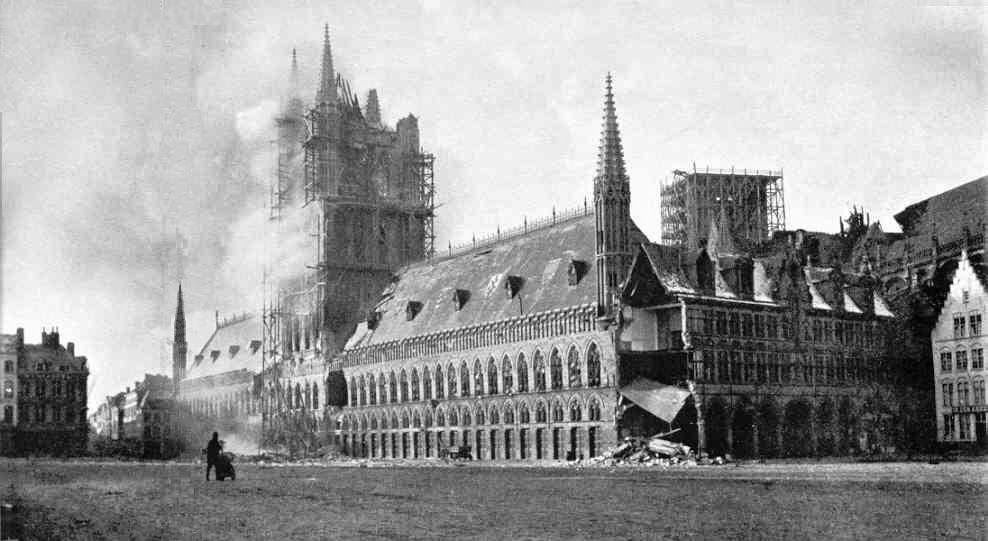Hamilton Gault had tried desperately to get back to his Regiment upon news of Farquhar's death but was under strict medical supervision and, much to his great disappointment, was not given permission to leave. As second in command, Gault was in line to replace the CO and command his beloved Regiment but the opportunity had been denied him. It was now up to Lieutenant-Colonel "Teta" Buller, Farquhar's lifelong friend and fellow member of the Vice Regal contingent from Ottawa, to follow in his legendary footsteps and he did so with stoic and courageous determination.
 |
| Lieutenant-Colonel H.C. "Teta" Buller, D.S.O. |
A quiet period followed the harrowing events at St. Eloi at the end of March. The men settled into an interval of rest and, for the first time since arriving on the continent, the sun was warm and spring was in the air. So promising was the change of seasons that Adamson sent the matted and dirty shreds of his fur coat and waders back to Mabel.
On April 5th the Patricias arrived in Ypres and were assigned to billets in a large schoolhouse where hot baths and the first change of clothes in a month were a welcome relief. The officers were billeted in a Ladies University which provided some amusement evident in Adamson's letter to Mable describing the assortment of fine ladies clothing and undergarments hastily left behind.
On April 5th the Patricias arrived in Ypres and were assigned to billets in a large schoolhouse where hot baths and the first change of clothes in a month were a welcome relief. The officers were billeted in a Ladies University which provided some amusement evident in Adamson's letter to Mable describing the assortment of fine ladies clothing and undergarments hastily left behind.
The city of Ypres was a thriving British and French garrison town in the spring of 1915. A popular tourist attraction and an important strategic landmark, it was also the target of determined German efforts to capture it over the next three years. Critical to the British hold on this sector of the Western Front, the Germans launched a major offensive against Ypres in November of 1914. The town was still relatively intact after the unsuccessful attack although some important landmarks had suffered massive damage. Undeterred, most of the 18,000 civilians continued to live in and around the town in spite of having lost over 250 people killed in the bombardment. The German shelling began to intensify in the area again come spring and in the early morning on April 6th, Germans shelled Ypres directly, killing and wounding 51 Royal Scots and several civilians.
When the Patricias occupied the town just the day before it was still bustling with markets and stores conducting business, almost oblivious to the war raging nearby. But the situation was quickly becoming more dangerous for the local people.
When the Patricias occupied the town just the day before it was still bustling with markets and stores conducting business, almost oblivious to the war raging nearby. But the situation was quickly becoming more dangerous for the local people.
 |
| The Cloth Hall burning after a direct hit, Ypres, November 1914 |
Although the town was still functioning well, the destruction from the November shelling was a constant reminder of the possibility of another attack. The railway station and St. Martin's Cathedral had been badly damaged, among many other buildings, but the historic 14th century Cloth Hall had taken a direct hit. Famous for its gothic architecture, the Cloth Hall had been the original inspiration for the Centre Block on Parliament Hill. One of the largest commercial buildings of the Middle Ages, it was the main market and warehouse for the prosperous Flemish textile industry. Though the roof of the Cloth Hall had been demolished the walls were still standing and was being used to billet up to 1,500 men.
On April 7th the battalion again marched off for the trenches. Positioned in support trenches north-east of Hooge along the southern edge of Polygon Wood, this new location allowed the Patricias a brief respite from the appalling conditions of their previous duties. The trenches were fairly dry and with well sandbagged parapets. LtCol Buller described them as "paradise after St. Eloi." The landscape surrounding Ypres was not yet destroyed by war and the Patricias were able to enjoy the picturesque countryside. The men were relatively safe here behind the line and wandered over to local farmhouses and village cafes to enjoy the comforts of community.
Soon the second battle of Ypres would begin. This densely populated region of Belgium would have to be completely evacuated. The historic cities and towns would be subjected to devastating bombardments that would render them nothing more than piles of rubble. The pastoral lands and lush woods would be obliterated and churned into putrid muddy burial grounds. In spite of enduring four years of brutal warfare, remarkably, the city of Ypres never would fall into German hands.